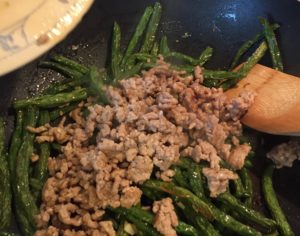Gan Bian Si Ji Do is the name of this signature Sichuan fried string bean dish. It is surprisingly easy to cook this the authentic way. And yet so few restaurants do it correctly.
I wrote in my last post that I was wonderfully surprised that I finally found one place that made it to perfection–at King Co Imperial in Brooklyn. I did not give the recipe in that post because I felt that this dish is good enough to be written about in two articles.
What makes this authentic is that the beans–regular, string beans–are deep fried first. Instead, most Chinese restaurants in the U.S. merely stir fry the beans, which makes it just fried beans and not gan bian beans. I can’t understand why restaurants can’t (or don’t know to) do this, especially since they usually already have a deep fryer right there for their use. I fry mine in my cast iron pot.
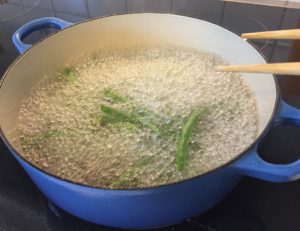
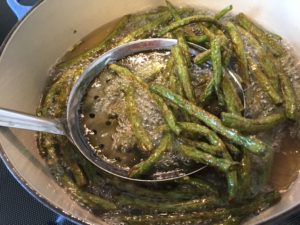
The gan bian process is firstly, deep frying the bean. After it is removed from the oil and drained, the beans are fried a second time in a “dry fried” technique. The deep-fried beans drained of its oil are tossed in a heated, dry wok. The beans are pressed down with the back of the spatula to squeeze out any remaining oil. This results is the beans sometimes having black, singed lines.
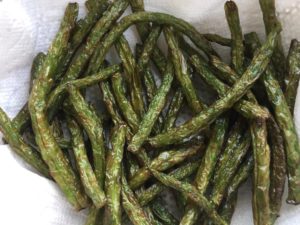
Even if you skip the second part of not dry frying the bean (which I did) the beans will get a much better texture than just simply stir frying it. Don’t get me wrong. Stir fried beans, with just a little salt or fish sauce added is delicious. I do it all the time. It’s just not the iconic Sichuan Gan Bian Si ji Do.
The texture of the gan bian bean is tender and soft and the bean looks kind of limp, shriveled and wilted. See the picture. I know, I know this description sounds unappetizing but it isn’t. If you just stir fry the bean, it is crunchy and crisp to the bite. Believe me, that added step makes the deep-fried bean taste completely different. It’s a wonderful texture.
After the beans are fried, they are then cooked like a regular stir-fry with the addition of pork, suan cai or pickled vegetable and seasoning. Typically only a little bit of pork–no more than ½ cup–is used. Also a dash of black vinegar is important in giving the dish a bright, perky flavor. The Chinkiang vinegar is my favorite and an important Chinese ingredient to have. Click here for post on Chinkiang vinegar.
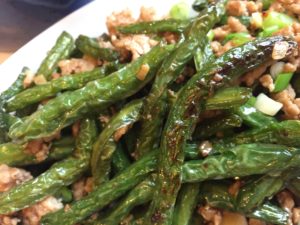
Sichuan Fried Beans – Gan Bian Si Ji Do
1½ pound string beans
2-4 ounces ground pork
1 teaspoon salt
Seasoning sauce
1 tablespoon soy sauce
¼ cup chicken stock
1 teaspoon salt
1 tablespoon Chekiang or wine vinegar
1 tablespoon sesame oil
4 cups oil
½ teaspoon chopped ginger
1 small clove garlic, finely chopped
1 tablespoon salted vegetables, finely chopped (optional)
2 spring onions, finely chopped
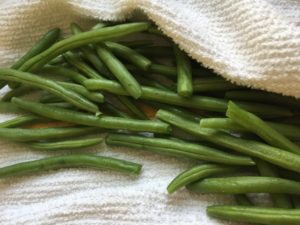 Trim beans, picking off stems. Wash and dry thoroughly in a clean towel.
Trim beans, picking off stems. Wash and dry thoroughly in a clean towel.
Marinate pork in salt and set aside. In a separate bowl, make seasoning sauce by combining soy sauce, chicken stock, salt, vinegar and sesame oil. Set aside.
Deep frying the beans: Heat oil in a 3-quart Dutch oven or wok. To monitor the heat of the oil, wait until you see some movement in the oil. Dip a wooden chopstick into the oil and when bubbles form at the tip of the chopstick the oil is hot enough to fry the beans.
For more on using a chopstick to gauge temperature for deep frying, click here on my post on Chopstick Thermometer.
Carefully lower beans into hot oil and fry until bean is shriveled and starting to get brown. Drain on kitchen paper towels.
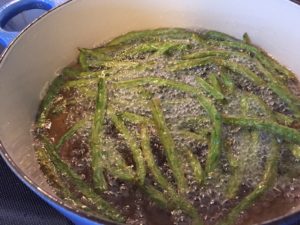
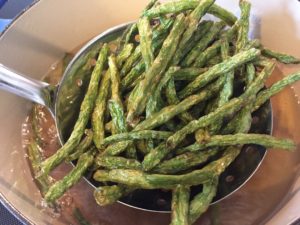
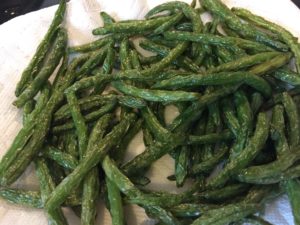
Heat a non-stick wok until surface is hot. Add bean and toss in the hot pan for two or three minutes. Transfer beans on to a dish and set aside.
Return wok to heat. Add 2 tablespoons of the hot oil into wok, add ginger and garlic and fry for a few seconds. Add pork and salted vegetables and fry quickly until pork is evenly cooked.
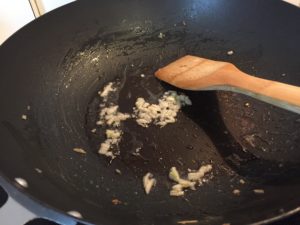
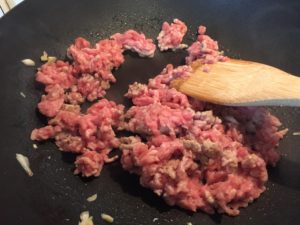
Return beans to pan and toss to mix ingredients together. Add seasoning sauce and fry quickly. Turn off heat, add spring onions. Transfer to serving dish.
